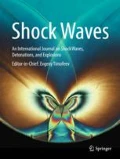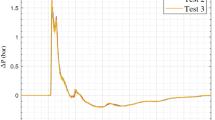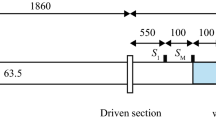Abstract
The interactions of planar shock waves with obstacles of different geometries were investigated numerically using large eddy simulation and a high-order numerical scheme. The immersed boundary method was also employed to handle complex boundary geometries. The development and variations of shock wave structures during the interaction processes were discussed. The influences of the upper side, windward and leeward geometries of the obstacles on shock wave attenuation were also examined. Our numerical results showed that the shock wave attenuation is inversely related to the width of the upper side of the obstacles. For the windward sides of the obstacles, negative slopes have better effects on shock wave attenuation than do other values. In addition, the influence of the leeward slope on shock wave attenuation is weaker than that of the upside and windward slopes. Finally, obstacle shapes with a high efficiency for shock wave attenuation have been obtained and validated.


















Similar content being viewed by others
References
Skews, B.W., Atkins, M.D., Seitz, M.W.: The impact of a shock wave on porous compressible foams. J. Fluid. Mech. 253, 245–265 (1993)
Britan, A., Vasiliev, E., Kulikovski, A.: Numerical simulation of the shock wave attenuation by the foam screen composed of a gas–liquid foam. Comb. Explos. Shock Waves 30(3), 135–141 (1994)
Kitagawa, K., Takayama, K., Yasuhara, M.: Attenuation of shock waves propagating in polyurethane foams. Shock Waves 15, 437–445 (2006)
Britan, A., Liverts, M., Shapiro, H., Ben-Dor, G., Chinnayya, A., Hadjadj, A.: Macro-mechanical modeling of blast-wave mitigation in foams. Part I: Review of available experiments and models. Shock Waves 23(1), 5–23 (2013)
Britan, A., Liverts, M., Shapiro, H., Ben-Dor, G.: Macro-mechanical modeling of blast-wave mitigation in foams. Part II: Reliability of pressure measurements. Shock Waves 23(1), 25–38 (2013)
Naiman, N., Knight, D.D.: The effect of porosity on shock interaction with a rigid porous barriers. Shock Waves 16, 321–337 (2007)
Levy, A., Ben-Dor, G., Skews, B.W., Sorek, S.: Head-on collision of normal shock waves with rigid porous materials. Exp. Fluids 15, 183–190 (2013)
Levy, A., Ben-Dor, G., Sorek, S.: Numerical investigation of the propagation of shock waves in rigid porous materials: flow field behavior and parametric study. Shock Waves 8, 127–137 (1998)
Kazemi-Kamyab, V., Subramaniam, K., Andreopoulos, Y.: Stress transmission in porous materials impacted by shock waves. J. Appl. Phys. 109, 013523 (2011)
Baer, M.R.: Numerical studies of dynamic compaction of inert and energetic granular materials. ASME J. Appl. Mech. 55, 36–43 (1988)
Britan, A., Ben-Dor, G., Igra, O., Shapiro, H.: Shock waves attenuation by granular filters. Int. J. Multiph. Flow 27, 617–634 (2001)
Chen, Z.H., Fan, B.C., Jiang, X.H.: Suppression effects of powder suppressants on the explosions of oxyhydrogen gas. J. Loss Prev. Process Ind. 19, 648–655 (2006)
Dosanjh, D.S.: Interaction of Grids with Travelling Shock Waves. NACA TN 3680 (1956)
Britan, A., Igra, O., Ben-Dor, G., Shapiro, H.: Shock wave attenuation by grids and orifice plates. Shock Waves 16, 1–15 (2006)
Berger, S., Sadot, O., Ben-Dor, G.: Experimental investigation on the shock-wave load attenuation by geometrical means. Shock Waves 20, 29–40 (2010)
Sasoh, A., Matsuoka, K., Nakashio, K., Timofeev, E., Takayama, K., Voinovich, P., Saito, T., Hirano, S., Ono, S., Makino, Y.: Attenuation of weak shock waves along pseudo-perforated walls. Shock Waves 8, 149–159 (1998)
Epstein, D.B., Kudryavtsev, A.N.: Shock and blast wave propagation through a porous barrier. In: 28th International Symposium on Shock Waves. Manchester, England, pp. 537–542 (2011)
Gongora-Orozco, N., Zare-Behtash, H., Kontis, K.: Experimental studies on shock wave propagating through junction with grooves. AIAA paper 2009–0327 (2009)
Sha, S., Chen, Z.H., Jiang, X.H.: Numerical investigations on blast wave attenuation by obstacles. Procedia Eng. 45, 453–457 (2012)
Andreopoulos, Y., Xanthos, S., Subramaniam, K.: Moving shocks through metallic grids: their interaction and potential for blast wave mitigation. Shock Waves 16, 455–466 (2007)
Misra, A., Pullin, D.I.: A vortex-based subgrid stress model for large-eddy simulation. Phys. Fluids 9, 2443–2454 (1997)
Kosovic, B., Pullin, D.I., Samtaney, R.: Subgrid-scale modelling for large-eddy simulations of compressible turbulence. Phys. Fluids 14, 1511–1522 (2002)
Pullin, D.I.: A vortex-based model for the subgrid flux of a passive scalar. Phys. Fluids 12, 2311–2319 (2000)
Jiang, G., Shu, C.W.: Efficient implementation of weighted ENO schemes. J. Comput. Phys. 126, 202–228 (1996)
Liu, X.D., Osher, S., Chan, T.: Weighted essentially non-oscillatory schemes. J. Comput. Phys. 115, 200–212 (1994)
Mittal, R., Iaccarino, G.: Immersed boundary methods. Annu. Rev. Fluid Mech. 37, 239–261 (2005)
Fedkiw, R., Aslam, T., Merriman, B., Osher, S.: A non-oscillatory Eulerian approach to interfaces in multimaterial flows (the ghost fluid method). J. Comput. Phys. 152, 457–492 (1999)
Miller, G.H., Colella, P.: A conservative three-dimensional Eulerian method for coupled solid–fluid shock capturing. J. Comput. Phys. 183, 26–82 (2002)
Schumann, U.: Subgrid-scale model for finite-difference simulations of turbulent flows in plane channels and annuli. J. Comput. Phys. 18, 376–404 (1975)
Schardin, H.: High frequency cinematography in the shock tube. J. Photo Sci. 5, 19–26 (1957)
Sha, S., Chen, Z.H., Zhang, H.H., Jiang, X.H.: Numerical investigations on the Schardin’s problem. Acta Phys. Sin. 61(6), 064702 (2012)
Acknowledgments
This research was supported by the National Natural Science Foundation of China (No. 11272156).
Author information
Authors and Affiliations
Corresponding author
Additional information
Communicated by A. Sasoh.
Rights and permissions
About this article
Cite this article
Sha, S., Chen, Z. & Jiang, X. Influences of obstacle geometries on shock wave attenuation. Shock Waves 24, 573–582 (2014). https://doi.org/10.1007/s00193-014-0520-9
Received:
Revised:
Accepted:
Published:
Issue Date:
DOI: https://doi.org/10.1007/s00193-014-0520-9




